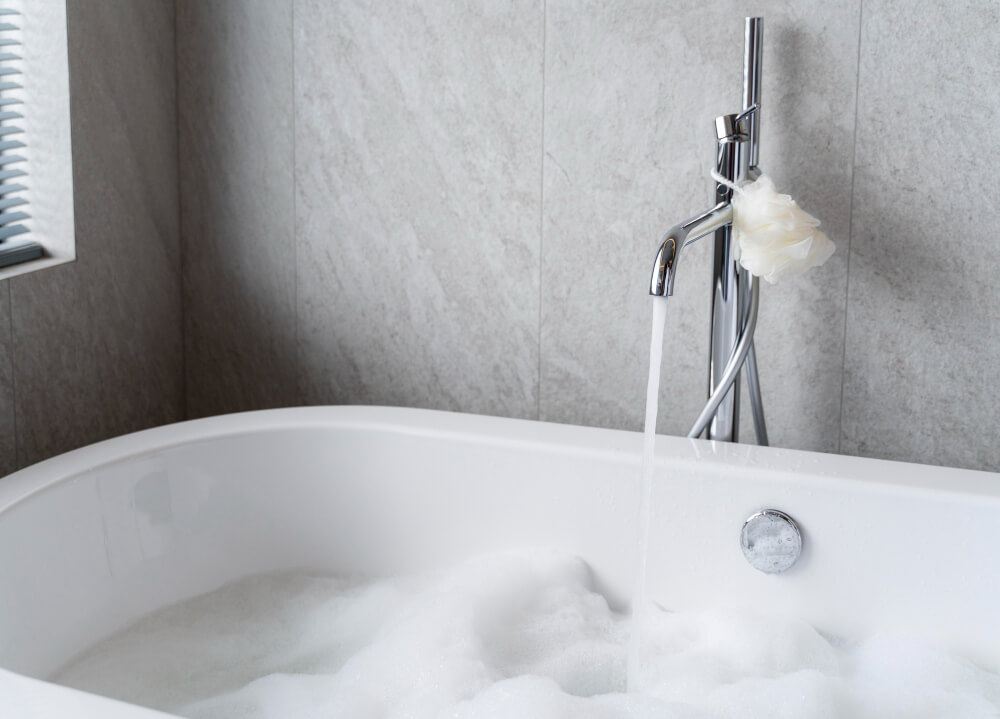
Taking a bath is a relaxing experience, but a large water bill may ruin it. Knowing just how many gallons a bathtub holds will allow you to judge how expensive it will be to use it. Alternatively, if you’re remodeling your bathroom, you can use its capacity to judge if your floor can support your tub’s weight when it’s in use.
However, each tub model has a different capacity. Therefore, you need to understand the features that limit how many gallons in a bathtub.
In this blog, you’ll discover the capacity of different tub types, how to calculate it, and how to reduce your water usage.
How Many Gallons Are in an Average Bathtub?

On average a tub will hold 40 – 60 gallons of water. The main reason why they’ll hold this much water is because of their average size. The average bathtub is 60” x 30” x 16”. Smaller tubs such as corner bathtubs are on the lower end with an average minimum capacity of 40 gallons. Meanwhile, larger tubs such as freestanding bathtubs have a capacity that’s closer to 90 – 100 gallons.
Depending on their size, tubs will hold different amounts of water. To compare these different bathtub capacities, you should examine this table:
| Tub Size | Average Capacity |
| Small | 20 – 40 Gallons |
| Medium | 40 – 60 Gallons |
| Large | 60+ Gallons |
Nevertheless, the type of the tub will also affect its average capacity range.
How Many Gallons Are in a Clawfoot Bathtub?
Despite their impressive size and aesthetic, clawfoot bathtubs are not nearly as large on the inside as other designs such as the freestanding tub. They hold an average of 40 – 60 gallons of water. If they’re oval or otherwise curved, they’ll hold closer to 40 gallons. However, if you order a highly customized clawfoot tub, it can hold over 60 gallons.
How Many Gallons Does a Drop-in Bathtub Hold?
Your drop-in bathtub may hold 60 – 80 gallons of water. Since these tubs are highly versatile, you may find smaller or larger models. Therefore, the space on the floor where you’ll install the tub will be a major factor in its size and capacity.
How Many Gallons of Water Are in a Bathtub-Shower Combination?
If you try to fill your bath with a shower-tub combination, you’ll likely use a minimum of 60 gallons of water. However, if you have a larger model, you may use up to 110 gallons. They may hold this amount of water because they’re wider and longer.
The Factors Affecting How Many Gallons Are in a Bathtub
Now that you know how much water the different types of tubs can hold, let’s explore the other factors that affect their capacity.
1. Dimensions
The most important factor in your tub’s capacity is its internal dimensions. Though the tub’s packaging may note its external dimensions, the internal ones affect its capacity. In particular, you’ll rely on the length, width, and depth of the interior of your tub to approximate its capacity. However, it’s not as simple as three measurements. Your tub also has a slope that allows water to drain easily. Therefore, this dimension will also affect how much water your tub can hold.
2. Overflow Level
The placement of the overflow hole will also affect your bathtub’s capacity. This hole diverts water to ensure that if you’ve left your bath running, it won’t overflow. Therefore, your tub can only hold water below this hole.
3. Shape
Another factor that affects your tub’s capacity is its internal shape. Generally, curves and angles in your bathtub will decrease its capacity. Therefore, even if your round tub overall takes up a large amount of space, it may still hold less water than a smaller, rectangular tub. Similarly, straight walls increase its capacity compared to sloped walls.
To compare these different shapes, you should examine this table:
| Tub Type | Average Capacity |
| Rectangular | 40 – 80 Gallons |
| Corner | 50 – 70 Gallons |
| Oval | 30 – 60 Gallons |
| Round | 20 – 40 Gallons |
4. Additional Features
If your tub has additional features such as a seat, it will displace some of the water, reducing its capacity. This is especially true with walk-in baths meant for those with mobility issues. They often have seats or other features that help you maneuver in and out of the tub.
5. Water Displacement
When you enter your bath, you’ll displace some of the water. So, even if your tub has a 100-gallon capacity, the water quantity it can actually hold while you use it is much smaller. Therefore, when you want to know how much water your specific bath can hold, you need to consider your body size. All the water you displace will then leave through the overflow hole or even spill over the tub’s sides.
Calculating How Many Gallons in a Bathtub
 Measuring the actual capacity of a bathtub is difficult. Your tub may have curves, a seat, and sloped walls. All of these features make your calculations less accurate. However, you can measure its approximate capacity by measuring the internal length, depth, and width of your tub. When you measure the depth, ensure you measure from just below the overflow hole to the bottom of the tub. Next, you’ll divide the cubic capacity by 231.
Measuring the actual capacity of a bathtub is difficult. Your tub may have curves, a seat, and sloped walls. All of these features make your calculations less accurate. However, you can measure its approximate capacity by measuring the internal length, depth, and width of your tub. When you measure the depth, ensure you measure from just below the overflow hole to the bottom of the tub. Next, you’ll divide the cubic capacity by 231.
(Length ✕ Depth ✕ Width) ÷ 231 = Bathtub Capacity
For example, if you have an alcove tub that’s 54” long, 18” deep, and 25” wide, it has a capacity of:
(54 ✕ 16 ✕ 25) ÷ 231 = 93.51 gallons
The Best Tips to Reduce Water Usage
If you desire to reduce the water you use in baths, follow these tips:
-
- Shorten Your Bath Time: You should take quicker baths and avoid refilling your tub with hot water.
- Reuse Bath Water: If you don’t use soap in your bath, you can reuse it to water your plants. Alternatively, you can also share bath water with family members.
- Switch to Showers: You should opt to shower instead of taking a bath since showers use less water, especially if they have a low-flow showerhead. For instance, the average 10-minute shower uses less than 20 gallons, while a bath can hold 110 gallons on the high end.
- Choose Lower Capacity Tubs: You should select a smaller, curved tub since they’ll have a smaller capacity.
- Select Heat Retaining Materials: Your tub’s material can affect its heat retention which in turn reduces how often you need to pour in more hot water to keep it at a comfortable temperature.
In particular, you can use the following materials:
- Cast Iron
- Copper
- Stone
- Acrylic
- Wood
Conclusion
All in all, how many gallons a bathtub can hold depends on its type, shape, and internal size. On average, they’ll hold 40 – 60 gallons of water. Meanwhile, larger bathtubs can hold as much as 110 gallons of water. However, this amount will change based on your specific model. In addition, other factors such as a seat in your bath can decrease your bath’s capacity.
To determine its specific capacity, you’ll need to measure its internal cubic size and divide it by 231. Nonetheless, this result is neither accurate nor the only number you need to consider in water usage. Therefore, take into account the water you’ll displace and the hot water you’ll add to keep your bath at a comfortable temperature.